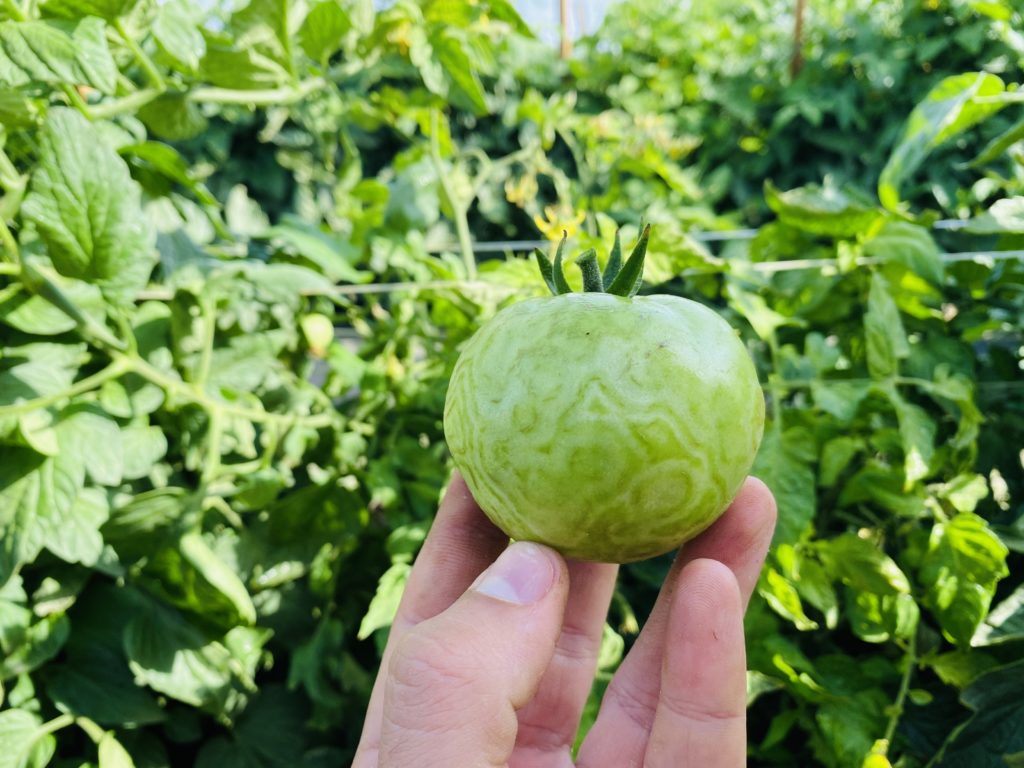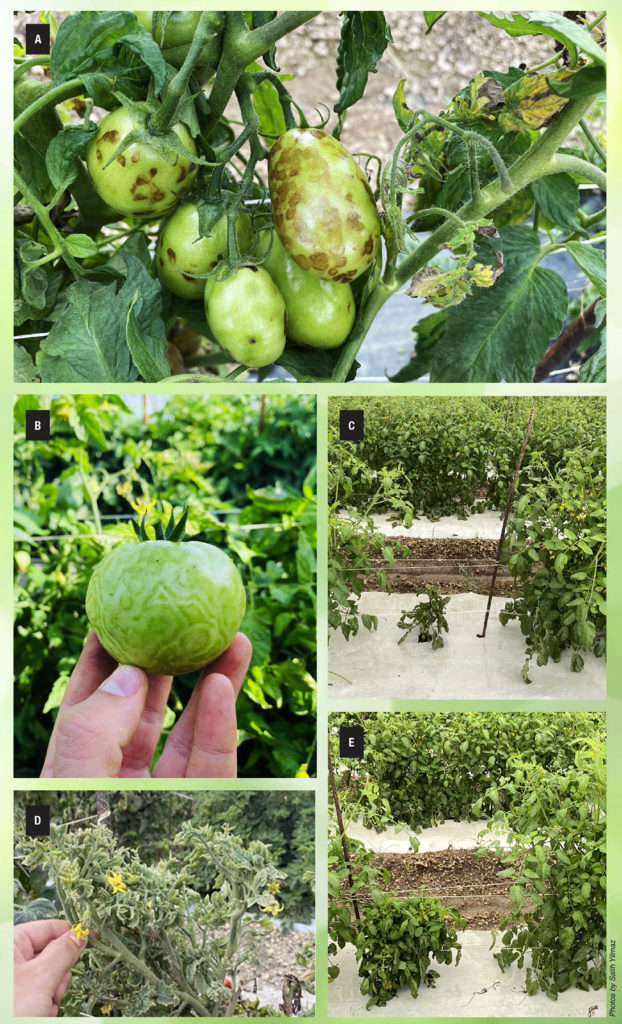By Ozgur Batuman and Salih Yilmaz
Florida is the leading state in the United States for the production of fresh market tomatoes. In recent years, the emergence of novel tomato-infecting virus species and resistance-breaking variants worldwide has raised concern for the tomato industry. More than 300 virus and virus-like pathogens have been reported to infect tomatoes, which collectively limits their production around the globe. In recent years, previously known and unknown viruses, including orthotospoviruses (tospoviruses, in short), begomoviruses and ilarviruses, started to emerge and cause harmful diseases in tomatoes in Florida.
Despite all these virus diseases, Florida tomato growers have remained resilient and judicious by using virus-resistant varieties when available. These include tomatoes with Ty genes (conferring resistance to whitefly-transmitted begomoviruses: i.e., Ty-1 to Ty-5), the Sw-5 gene (conferring resistance to thrips-transmitted tospoviruses) and Tm genes (conferring resistance to seed/contact-transmitted tobamoviruses: i.e., Tm-2 and Tm-22). These practices have been helping growers fend off most of the virus diseases in their nurseries and fields.
However, intensive and increasing use of resistant tomato varieties throughout Florida builds selection pressure on viruses, forcing them to overcome resistance by mutating into resistance-breaking (new or emerging) virus variants. Consequently, the emergence of such variants would drastically alter the function of these protective genes in resistant tomatoes, which are currently a critical component of the effective integrated disease management strategy and may render Florida tomatoes vulnerable again.
To better understand whether resistance breaking occurs in Florida tomatoes, 20 different tomato fields, mainly established with Sw-5-resistant varieties, were surveyed throughout Collier, Gadsden, Hendry, Palm Beach, Manatee and Miami-Dade counties. These surveys are still ongoing in collaboration with several tomato growers and researchers at the University of Florida Institute of Food and Agricultural Sciences (UF/IFAS) and the U.S. Department of Agriculture (USDA) Agricultural Research Service and funded by the USDA National Plant Disease Recovery System.

TCSV AND TSWV
More than 300 symptomatic tomato plant samples supposedly having resistance genes, yet exhibiting various virus and virus-like symptoms, were collected during the 2019–2022 growing seasons. Among them, 112 samples were infected with tomato chlorotic spot virus (TCSV) and nine with tomato spotted wilt virus (TSWV).
Field observations and accompanying laboratory molecular diagnostic test results suggested that Sw-5 tomato varieties might be partially resistant to TCSV infection. Most of the infected plants collected had the Sw-5 gene and typical systemic tospovirus-like symptoms (i.e., all plant parts showing disease symptoms; Figure 1A and Figure 1B), particularly in Miami-Dade County.
Because the TCSV movement protein is responsible for systemic infection, which is recognized and blocked by the Sw-5 resistant gene, all the TCSV isolates collected were analyzed to see if this gene was mutated. The analysis showed the presence of multiple mutations in the virus, some with resistance-breaking potential. Some of these mutations are similar to those found in movement protein of established resistance-breaking TSWV isolates in tomatoes in California and some European countries.
Therefore, UF/IFAS researchers are now trying to inoculate several resistant tomato varieties to study how these mutant variants would behave in tomato plants. Soon, the results of these studies will help determine whether there is a resistance-breaking tospovirus in Florida tomato fields.
TOMATO NECROTIC STREAK VIRUS
Another virus, tomato necrotic streak virus (TomNSV), an ilarvirus transmitted by pollen during thrips feeding, was also found in four different severely infected tomato samples collected from Miami-Dade County (Figure 1C). Additional surveys in 2020 revealed an abundance of sequences with low similarities to TomNSV and other members of the Ilarvirus genus in some of the tomato samples with similar symptoms caused by TomNSV.
These low-level genetic similarities with different ilarviruses suggest the novelty of this ilarvirus, which was unknown to infect tomato plants or occur in Florida fields before (Figure 1E). Lab studies to characterize this putative newly emerging virus are now in progress. However, due to its similarity to TomNSV, researchers cautiously presume that this putative new virus is currently not posing a threat to tomatoes in Florida.
OTHER VIRUSES
The good news is that tomato brown rugose fruit virus (ToBRFV), another resistance-breaking virus that continues to emerge in production regions around the globe, has not been found in any Florida field-collected samples thus far. However, another tobamovirus in Florida, tomato mosaic virus, which is not a resistance-breaking virus, was found to co-infect two of the tomato samples with TCSV.
Lastly, tomato yellow leaf curl virus (TYLCV), which causes widespread disease in fields with high whitefly populations, was found in 87 collected tomato samples displaying typical stunted growth and shoot yellowing symptoms (Figure 1D). These samples were also tested for a possible satellite virus, a virus known to help TYLCV overcome Ty resistant genesin tomatoes. Fortunately, test results thus far did not find any evidence of the satellite virus presence in these suspected samples.

Photos by Salih Yilmaz
SUMMARY
In summary, field surveys and laboratory test results to date have not shown convincing evidence for the presence of any resistance-breaking virus variants in any of the tested plants. However, several mutations detected in the movement protein gene of the TCSV isolates are currently unknown in their potential to cause resistance breaking and are under further evaluation.
Nonetheless, tomato production in Florida is constantly threatened by the emergence of new virus diseases or resistance-breaking variants. New virus disease outbreaks in tomato production can result in losses of millions of dollars for the industry and the state economy. Therefore, growers should continue to stay vigilant, use virus-resistant tomato varieties (especially in fields with hot spots), and monitor fields for virus symptoms and insect vectors and manage them.
GROWER RESOURCES
If growers see unusual symptoms or suspect they may have a new virus-like disease, they should immediately contact their local Extension office for assistance. Submit samples to a local UF/IFAS Plant Diagnostic Lab or call the Florida Department of Agriculture and Consumer Services Division of Plant Industry helpline at 352-395-4600.
See edis.ifas.ufl.edu/publication/PP360 for answers to ToBRFV questions and more comprehensive information on the disease. If assistance is needed with testing for viruses, contact your county Extension agent or Ozgur Batuman (obatuman@ufl.edu) at the UF/IFAS Southwest Florida Research and Education Center (SWFREC).
Ozgur Batuman is an assistant professor, and Salih Yilmaz is a graduate student, both at the UF/IFAS SWFREC in Immokalee.










